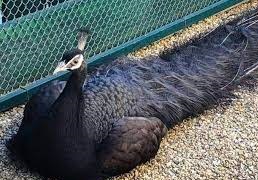
Black peacocks, also known as melanistic peafowls, are a captivating variant of the more commonly recognized Indian peafowl. With their lustrous black feathers, these stunning birds exhibit a unique and mesmerizing beauty.
In this article, we will delve into the enchanting world of black peacocks, exploring their physical characteristics, habitat, behavior, and significance in various cultures.
Physical Characteristics
Black peacocks possess distinct features that set them apart from their colorful counterparts. Their plumage is predominantly black, with a subtle iridescence that reveals shades of blue, green, and purple in certain lighting conditions.
The vibrant hues of their tail feathers can be observed when the feathers are fanned out during courtship displays. Unlike other peafowls, black peacocks lack the prominent eye-spots on their tail feathers, emphasizing the elegance of their black plumage.
Habitat and Distribution
Black peacocks are native to the Indian subcontinent and are primarily found in the forests of India, Sri Lanka, and Bangladesh. They inhabit a diverse range of habitats, including tropical forests, grasslands, and scrublands. These adaptable birds have also been introduced to various other regions worldwide, where they have established feral populations.
Diet and Feeding Habits
Black peacocks are omnivorous birds with a varied diet. They primarily feed on plant matter such as fruits, seeds, and leaves. Additionally, they consume insects, small reptiles, and amphibians. Their foraging behavior is characterized by scratching the ground with their feet to uncover food items.
Breeding and Reproduction
During the breeding season, black peacocks engage in elaborate courtship displays to attract females. The males erect their long, sweeping tail feathers into a stunning fan-shaped display and perform rhythmic dances accompanied by vocalizations. These displays are meant to impress the females and establish dominance among competing males. Once a female has chosen a mate, she constructs a nest on the ground, where she lays her eggs. The incubation period lasts for about a month, and the female is solely responsible for incubating the eggs.
Behavior and Social Structure
Black peacocks are generally solitary birds, although they may gather in small groups during non-breeding periods. They are diurnal creatures, being most active during the early morning and late afternoon. These birds are highly territorial and defend their territories vigorously, often engaging in aggressive displays towards intruders.
Cultural Significance
Peacocks, including their black variants, have held cultural significance in various societies throughout history. In Hindu mythology, the peacock is associated with the deity Lord Murugan, symbolizing beauty, knowledge, and fertility. In different cultures, peacock feathers have been used for ornamental purposes, adorning garments, accessories, and home decor. The striking appearance of black peacocks continues to captivate artists, writers, and nature enthusiasts alike.
Conservation Status and Threats
While the Indian peafowl, including the black peacock, is not currently listed as endangered, habitat loss and hunting pose significant threats to their populations. Deforestation, agricultural expansion, and urbanization have led to the fragmentation of their habitats. Additionally, illegal poaching for their feathers and body parts remains a concern. Conservation efforts, including protected areas and awareness campaigns, are crucial to ensure the survival of these remarkable birds for future generations.
Conclusion
The alluring beauty of black peacocks adds an enchanting dimension to the natural world. With their striking black plumage and majestic courtship displays, they continue to captivate and inspire awe in observers. As we strive to conserve and appreciate the diversity of our planet’s wildlife, the black peacock serves as a reminder of the extraordinary wonders that exist in nature.
FAQs
Are black peacocks a separate species?
No, black peacocks are a melanistic variant of the Indian peafowl.
Do black peacocks fly?
Yes, black peacocks, like other peafowls, are capable of flying, although they spend most of their time on the ground.
Are black peacocks rare?
While black peacocks are not as common as their colorful counterparts, they can be found in certain regions where the melanistic variant occurs.
Why don’t black peacocks have eye-spots on their tail feathers?
The absence of eye-spots in black peacocks is a genetic variation. The focus is on their stunning black plumage.
Can black peacocks interbreed with other peafowl variants?
Yes, black peacocks can interbreed with other variants, resulting in hybrid offspring with unique characteristics.